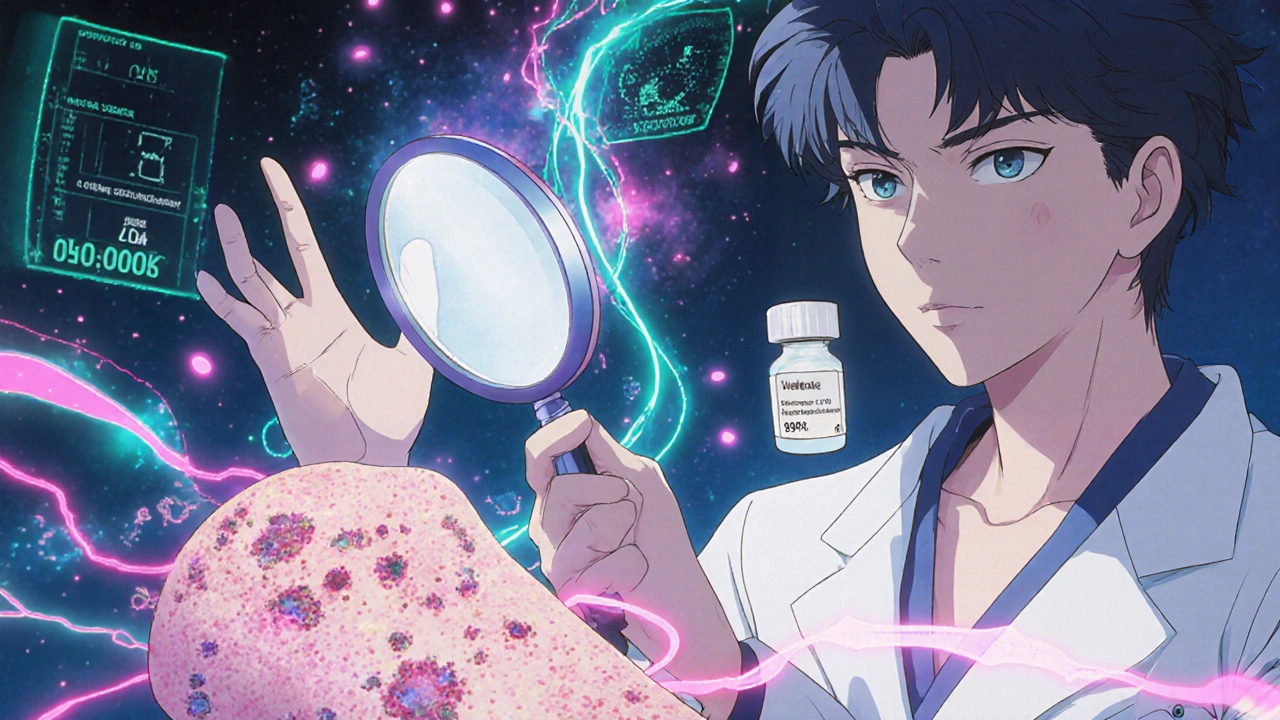AGEP Symptom Checker
This tool is for educational purposes only and does not provide a medical diagnosis. AGEP is a serious skin condition that requires immediate medical attention. If you experience these symptoms, stop taking any new medication and contact your doctor right away.
Key Symptoms of AGEP
Select symptoms you're experiencing. This tool is designed to help you understand if your symptoms match those described in the article about Acute Generalized Exanthematous Pustulosis (AGEP).
Results
Symptom Match: 0%
Important: This tool is for educational purposes only. It does not diagnose medical conditions.
If you have these symptoms, you should:
- Stop taking the new medication immediately
- Seek medical attention right away (urgent care or ER)
- Bring your medication list with you
- Inform your doctor that you may have AGEP
According to the article, AGEP is a rapid-onset skin reaction that appears within hours to days after starting a medication. It's characterized by thousands of tiny, sterile pustules on red, inflamed skin. Most people recover fully within 10-14 days after stopping the triggering drug.
Remember: AGEP is rarely deadly (mortality 2-4%), but it requires prompt medical attention to avoid complications and ensure proper treatment.
AGEP is not just a rash. It’s a sudden, alarming skin reaction that can turn your body red and covered in tiny, pus-filled bumps within hours - often after taking a common medication you’ve used before without issue. Unlike acne or heat rash, these pustules aren’t infected. They’re sterile, meaning no bacteria are present. Yet they look terrifying. And they come fast. Most people notice the first signs within 24 to 48 hours after taking a drug, sometimes as late as two weeks. The skin feels hot, burns, and may peel days later. If you’ve ever woken up covered in small white dots on a red background and felt feverish, you’re not imagining it. This could be AGEP - and it needs quick attention.
What Does AGEP Actually Look Like?
Imagine your skin turning bright red, like a bad sunburn, but then suddenly dotted with hundreds of pinhead-sized white or yellowish bumps. These aren’t pimples. They don’t have hair follicles in the center. They appear mostly in skin folds - armpits, groin, under the breasts - then spread quickly to the chest, back, and face. The face often gets hit early, which is unusual for most drug rashes. The pustules are tiny, usually 1 to 2 millimeters across, and they don’t merge into larger patches like in psoriasis. The skin underneath is inflamed and tender. Many patients report burning or stinging more than itching, though itching can happen too.
One key thing that sets AGEP apart from other rashes: it doesn’t start with blisters or open sores. That’s what separates it from Stevens-Johnson Syndrome, a more dangerous reaction. AGEP also doesn’t usually affect the palms or soles - unless it’s mistaken for pustular psoriasis, which is a common error. And unlike psoriasis, which can flare for weeks or months, AGEP fades fast - if caught early.
What Causes It?
Over 90% of AGEP cases are triggered by medications. It’s not allergies in the classic sense - no IgE antibodies involved. It’s more like your immune system misfires, flooding the skin with neutrophils (a type of white blood cell) that form those pustules. The most common culprits? Antibiotics. Specifically, amoxicillin-clavulanate (Augmentin), erythromycin, and other beta-lactams. These account for about 56% of all cases, according to the EuroSCAR study.
Other frequent offenders include antifungals like terbinafine, calcium channel blockers like diltiazem, and even some NSAIDs. Surprisingly, even corticosteroids - drugs meant to calm inflammation - have been known to trigger AGEP. One case report showed a patient developed the rash after taking prednisolone, yet responded fine to methylprednisolone later. That’s why doctors don’t automatically assume all steroids are off-limits.
It’s not about dosage. Even a single pill can do it. And it’s not always the first time you’ve taken the drug. People often react after months or years of safe use. That’s why it catches so many off guard.
How Is It Diagnosed?
Diagnosing AGEP isn’t easy. In community clinics, up to 40% of cases are misdiagnosed - often as psoriasis, folliculitis, or even an allergic reaction. Dermatologists use a mix of clinical signs, timing, and lab tests. Key clues:
- Rash appears 1-5 days after starting a new drug (median: 2 days)
- Thousands of small, non-follicular pustules on red skin
- High white blood cell count with neutrophils over 75%
- Elevated CRP (a marker of inflammation)
- No blisters, no mucosal involvement (unlike SJS)
A skin biopsy confirms it. Under the microscope, you’ll see pustules just below the top skin layer, filled with neutrophils, surrounded by swollen tissue. No fungi, no bacteria. Just inflammation gone wild.
A new diagnostic tool called the AGEP Probability Score (APS) is now being used in major hospitals. Developed by the EuroSCAR group, it scores symptoms, timing, and lab results. It’s 94% accurate at spotting AGEP - far better than guesswork.

How Serious Is It?
It’s scary-looking, but the good news? AGEP is rarely deadly. Mortality is only 2-4%, compared to 20-25% for generalized pustular psoriasis. Most people recover fully within 10 to 14 days after stopping the drug. No long-term scarring. No chronic skin damage. The body usually resets itself.
But complications can happen. High fever (over 38.5°C), dehydration, or widespread rash (more than 20% of skin surface) means you need hospital care. Some patients get secondary infections. Others develop temporary liver enzyme changes. The real danger? Delayed diagnosis. If doctors mistake it for psoriasis and prescribe immune-suppressing drugs like methotrexate, things can go wrong fast.
Treatment: What Works and What Doesn’t
The single most important step? Stop the drug. Immediately. No exceptions. That’s all you need in most cases. Once the trigger is removed, the rash begins fading within days.
Supportive care is the backbone of treatment:
- Moist compresses or cool baths to soothe burning skin
- Topical corticosteroids (low to mid-potency) for localized relief
- Antihistamines if itching is bothersome
- Hydration and fever control with acetaminophen
But here’s where things get controversial: should you use oral steroids like prednisone?
Some experts say no. Dermatology Advisor and doctors from Baylor College of Medicine argue that AGEP is self-limiting. Steroids add side effects - weight gain, blood sugar spikes, mood changes - without clear benefit. They’ve seen 15 cases over three years. All resolved without steroids.
Other experts, including a European panel published in 2023, say yes - if the rash is severe. In their study, patients with over 20% skin involvement who got steroids healed in 7 days on average. Those who didn’t took 11 days. That’s a 4-day difference. And fewer days in the hospital.
So what’s the answer? It depends. If you’re otherwise healthy with mild rash - skip steroids. If you’re elderly, diabetic, or have over a quarter of your skin covered? Steroids may help. The American Journal of Clinical Dermatology says: “Individualize treatment.” There’s no one-size-fits-all.
For cases that don’t respond? New options are emerging. Cyclosporine - an immune modulator - works as well as steroids but with fewer metabolic side effects. Even more exciting: biologics. Secukinumab (Cosentyx), a drug used for psoriasis, has been used successfully in AGEP. One patient got complete clearance in 72 hours. Another saw improvement in under 48 hours. These drugs target IL-17, a key inflammatory pathway in AGEP. Clinical trials are now underway to test them more broadly.
What Happens After the Rash Goes Away?
Once the pustules fade, the skin starts peeling - like a sunburn. This is normal. It can last a week or more. This is when patients need clear instructions. A 2022 study found that people who got written advice on moisturizing and sun protection had a 78% compliance rate. Those who only got verbal tips? Just 42%. That’s a huge gap.
Use fragrance-free emollients daily. Avoid direct sunlight. Don’t scrub the skin. You’re still vulnerable to irritation. And never take the drug that caused it again. Ever. Cross-reactions are common - if amoxicillin-clavulanate triggered your AGEP, you’re at high risk for reacting to other penicillins.

What’s Changing in AGEP Care?
Things are moving fast. In 2021, the FDA updated its guidelines to require drug makers to monitor for AGEP in clinical trials - especially for antibiotics and heart meds. The European Medicines Agency has done the same. Drug labels now list AGEP as a possible side effect for amoxicillin-clavulanate, terbinafine, and diltiazem.
Genetic research is also advancing. Scientists found that people with the HLA-B*59:01 gene variant - common in Asian populations - are nearly 9 times more likely to develop AGEP after certain drugs. That means, in the future, we might screen high-risk patients before prescribing. Imagine knowing you’re genetically prone to a reaction before you even take the pill.
And the future? Biologics like secukinumab could become first-line for severe cases. The AGEP 2.0 diagnostic tool will soon be widely adopted. And registries like RegiSCAR are tracking 312 patients over five years to understand long-term outcomes.
When to Seek Help
If you develop a sudden rash with pustules after starting a new medication - especially if you have a fever, feel unwell, or the rash spreads quickly - don’t wait. Go to urgent care or the ER. Bring your medication list. Say: “I think I might have AGEP.” That phrase alone will get you to the right specialist faster.
Don’t try to treat it with over-the-counter creams unless you’re sure it’s not something worse. And never restart the drug, even if you think it was a “one-time thing.”
Can AGEP come back if I take the same drug again?
Yes - and it’s likely to be worse. Once you’ve had AGEP from a specific drug, your immune system remembers it. Re-exposure can cause a faster, more severe reaction, sometimes life-threatening. You must avoid that drug and related ones for life. Your doctor should document this in your medical record and alert all future providers.
Is AGEP contagious?
No. AGEP is not caused by an infection and cannot spread from person to person. The pustules are sterile - they contain immune cells, not bacteria or viruses. You can safely touch or care for someone with AGEP without risk.
Can children get AGEP?
Yes, though it’s rare. Most cases occur in adults, but children - especially those on antibiotics like amoxicillin - can develop it. The symptoms and treatment are similar. Parents should watch for sudden redness and pustules after starting a new medication and seek medical care immediately.
How long does it take to recover from AGEP?
Most people start improving within 2-3 days after stopping the drug. The rash clears completely in 10-14 days. Skin peeling may continue for another week. Hospital stays average 5-9 days for severe cases. Full recovery without scarring is the norm.
Are there any long-term effects of AGEP?
Usually not. AGEP doesn’t cause chronic skin problems, organ damage, or increased cancer risk. The main long-term risk is accidental re-exposure to the triggering drug. That’s why keeping a list of drug triggers and sharing it with every doctor is critical. Some patients report temporary changes in skin sensitivity, but these fade over time.
What to Do Next
If you’ve had AGEP, make a list: drug name, date taken, symptoms, and doctor’s diagnosis. Keep it in your wallet or phone. Tell every new provider about it. Ask for an allergy bracelet if you’re sensitive to multiple drugs. If you’re currently on a medication and notice any unusual skin changes - stop it and call your doctor. Don’t wait. AGEP moves fast. So should your response.

Rashmi Mohapatra
November 6, 2025 AT 03:22Abigail Chrisma
November 7, 2025 AT 10:23Ankit Yadav
November 8, 2025 AT 06:29Meghan Rose
November 9, 2025 AT 02:16Steve Phillips
November 9, 2025 AT 05:12Rachel Puno
November 10, 2025 AT 07:16Clyde Verdin Jr
November 11, 2025 AT 08:52Key Davis
November 12, 2025 AT 19:50Cris Ceceris
November 13, 2025 AT 06:36Brad Seymour
November 14, 2025 AT 17:37Malia Blom
November 16, 2025 AT 02:14